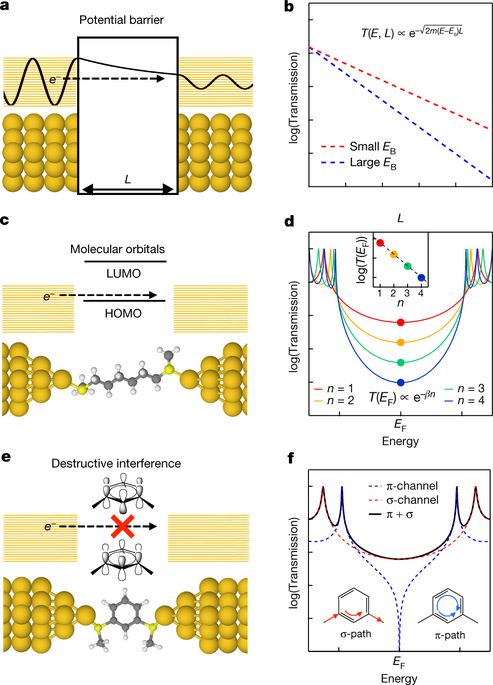Our official English website, www.x-mol.net, welcomes your feedback! (Note: you will need to create a separate account there.)
Comprehensive suppression of single-molecule conductance using destructive σ-interference
Nature ( IF 64.8 ) Pub Date : 2018-06-01 , DOI: 10.1038/s41586-018-0197-9 Marc H. Garner , Haixing Li , Yan Chen , Timothy A. Su , Zhichun Shangguan , Daniel W. Paley , Taifeng Liu , Fay Ng , Hexing Li , Shengxiong Xiao , Colin Nuckolls , Latha Venkataraman , Gemma C. Solomon
Nature ( IF 64.8 ) Pub Date : 2018-06-01 , DOI: 10.1038/s41586-018-0197-9 Marc H. Garner , Haixing Li , Yan Chen , Timothy A. Su , Zhichun Shangguan , Daniel W. Paley , Taifeng Liu , Fay Ng , Hexing Li , Shengxiong Xiao , Colin Nuckolls , Latha Venkataraman , Gemma C. Solomon

|
The tunnelling of electrons through molecules (and through any nanoscale insulating and dielectric material1) shows exponential attenuation with increasing length2, a length dependence that is reflected in the ability of the electrons to carry an electrical current. It was recently demonstrated3–5 that coherent tunnelling through a molecular junction can also be suppressed by destructive quantum interference6, a mechanism that is not length-dependent. For the carbon-based molecules studied previously, cancelling all transmission channels would involve the suppression of contributions to the current from both the π-orbital and σ-orbital systems. Previous reports of destructive interference have demonstrated a decrease in transmission only through the π-channel. Here we report a saturated silicon-based molecule with a functionalized bicyclo[2.2.2]octasilane moiety that exhibits destructive quantum interference in its σ-system. Although molecular silicon typically forms conducting wires7, we use a combination of conductance measurements and ab initio calculations to show that destructive σ-interference, achieved here by locking the silicon–silicon bonds into eclipsed conformations within a bicyclic molecular framework, can yield extremely insulating molecules less than a nanometre in length. Our molecules also exhibit an unusually high thermopower (0.97 millivolts per kelvin), which is a further experimental signature of the suppression of all tunnelling paths by destructive interference: calculations indicate that the central bicyclo[2.2.2]octasilane unit is rendered less conductive than the empty space it occupies. The molecular design presented here provides a proof-of-concept for a quantum-interference-based approach to single-molecule insulators.Highly insulating silicon-based molecules, engineered so that conduction is fully suppressed by σ quantum interference even for molecules less than a nanometre long, could prove useful in molecular-scale electronic circuitry.
中文翻译:

使用破坏性 σ 干扰全面抑制单分子电导
电子通过分子(以及通过任何纳米级绝缘和介电材料1)的隧道随着长度的增加呈指数衰减2,长度依赖性反映在电子携带电流的能力上。最近证明 3-5,通过分子结的相干隧穿也可以被破坏性量子干涉 6 抑制,这是一种不依赖于长度的机制。对于先前研究的碳基分子,取消所有传输通道将涉及抑制 π 轨道和 σ 轨道系统对电流的贡献。先前关于破坏性干扰的报告表明,仅通过 π 通道的传输会减少。在这里,我们报告了一种具有官能化双环的饱和硅基分子[2.2。2]在其σ-系统中表现出破坏性量子干涉的八硅烷部分。尽管分子硅通常形成导线 7,但我们结合使用电导测量和从头计算来表明破坏性 σ 干扰,这里通过将硅 - 硅键锁定为双环分子框架内的重叠构象来实现,可以产生极绝缘的分子长度不到一纳米。我们的分子还表现出异常高的热电势(每开尔文 0.97 毫伏),这是通过相消干涉抑制所有隧道路径的进一步实验特征:计算表明,中心双环 [2.2.2] 八硅烷单元的导电性低于它占据的空白空间。
更新日期:2018-06-01
中文翻译:

使用破坏性 σ 干扰全面抑制单分子电导
电子通过分子(以及通过任何纳米级绝缘和介电材料1)的隧道随着长度的增加呈指数衰减2,长度依赖性反映在电子携带电流的能力上。最近证明 3-5,通过分子结的相干隧穿也可以被破坏性量子干涉 6 抑制,这是一种不依赖于长度的机制。对于先前研究的碳基分子,取消所有传输通道将涉及抑制 π 轨道和 σ 轨道系统对电流的贡献。先前关于破坏性干扰的报告表明,仅通过 π 通道的传输会减少。在这里,我们报告了一种具有官能化双环的饱和硅基分子[2.2。2]在其σ-系统中表现出破坏性量子干涉的八硅烷部分。尽管分子硅通常形成导线 7,但我们结合使用电导测量和从头计算来表明破坏性 σ 干扰,这里通过将硅 - 硅键锁定为双环分子框架内的重叠构象来实现,可以产生极绝缘的分子长度不到一纳米。我们的分子还表现出异常高的热电势(每开尔文 0.97 毫伏),这是通过相消干涉抑制所有隧道路径的进一步实验特征:计算表明,中心双环 [2.2.2] 八硅烷单元的导电性低于它占据的空白空间。



























 京公网安备 11010802027423号
京公网安备 11010802027423号